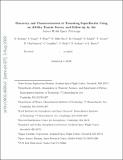Discovery and Characterization of Transiting Super Earths Using an All-Sky Transit Survey and Follow-up by the James Webb Space Telescope
Author(s)
Seager, Sara; Winn, Joshua Nathan; Deming, Drake; Miller-Ricci, Eliza; Clampin, M.; Lindler, D.; Greene, Tom; Charbonneau, David; Laughlin, G. P.; Latham, David W.; Ennico, K.; Ricker, George R; ... Show more Show less
DownloadSeager_Discovery and characterization.pdf (1.433Mb)
OPEN_ACCESS_POLICY
Open Access Policy
Creative Commons Attribution-Noncommercial-Share Alike
Terms of use
Metadata
Show full item recordAbstract
Doppler and transit surveys are finding extrasolar planets of ever smaller mass and radius, and are now sampling the domain of super Earths (1–3R⊕). Recent results from the Doppler surveys suggest that discovery of a transiting super Earth in the habitable zone of a lower main sequence star may be possible. We evaluate the prospects for an all-sky transit survey targeted to the brightest stars, that would find the most favorable cases for photometric and spectroscopic characterization using the James Webb Space Telescope (JWST). We use the proposed Transiting Exoplanet Survey Satellite (TESS) as representative of an all-sky survey. We couple the simulated TESS yield to a sensitivity model for the MIRI and NIRSpec instruments on JWST. Our sensitivity model includes all currently known and anticipated sources of random and systematic error for these instruments. We focus on the TESS planets with radii between those of Earth and Neptune. Our simulations consider secondary eclipse filter photometry using JWST/MIRI, comparing the 11 and 15 μm bands to measure CO2 absorption in super Earths, as well as JWST/NIRSpec spectroscopy of water absorption from 1.7–3.0 μm, and CO[subscript 2] absorption at 4.3 μm. We find that JWST will be capable of characterizing dozens of TESS super Earths with temperatures above the habitable range, using both MIRI and NIRspec. We project that TESS will discover about eight nearby habitable transiting super Earths, all orbiting lower–main-sequence stars. The principal sources of uncertainty in the prospective JWST characterization of habitable super Earths are super-Earth frequency and the nature of super-Earth atmospheres. Based on our estimates of these uncertainties, we project that JWST will be able to measure the temperature and identify molecular absorptions (water, CO[subscript 2]) in one to four nearby habitable TESS super Earths orbiting lower–main-sequence stars.
Date issued
2009-08Department
Massachusetts Institute of Technology. Department of Earth, Atmospheric, and Planetary Sciences; Massachusetts Institute of Technology. Department of Physics; MIT Kavli Institute for Astrophysics and Space ResearchJournal
Publications of the Astronomical Society of the Pacific
Publisher
University of Chicago Press, The
Citation
Deming, D. et al. “Discovery and Characterization of Transiting Super Earths Using an All-Sky Transit Survey and Follow-up by the James Webb Space Telescope.” Publications of the Astronomical Society of the Pacific 121.883 (2009): 952–967.
Version: Author's final manuscript
ISSN
0004-6280
1538-3873